Did you know that the number of powerlifting competitions worldwide is expected to surge by 20% in 2025? As more athletes enter the sport, having the right powerlifting belt becomes crucial for both safety and peak performance.
Many lifters, from beginners to seasoned pros, make mistakes like choosing the wrong size or relying on poor materials. The right powerlifting belt offers vital support, helps stabilize your core, and can enhance your lifting power while reducing injury risk.
This guide will walk you through everything you need to know to pick the best belt for your goals. We will cover how belts work, different types, sizing, materials, key features, top brands, and expert buying tips. Ready to maximize your lifting in 2025? Read on to discover how the right powerlifting belt can transform your training.
The Science Behind Powerlifting Belts: Why Support Matters
Proper support is the foundation of safe and powerful lifting. As more lifters turn to the powerlifting belt for an edge, understanding the science behind these belts is crucial. When used correctly, a powerlifting belt can be your secret weapon for both performance and protection.

Core Function of a Powerlifting Belt
The main job of a powerlifting belt is to boost intra-abdominal pressure. This pressure acts like a natural brace for your spine, making it much safer to move heavy loads. When you wear a powerlifting belt and brace your core, it creates a stabilizing effect that reduces stress on your lower back.
Studies show that using a powerlifting belt can increase lifting performance by up to 15 percent. This means you might be able to squat or deadlift more weight with the same effort. The type of lift also matters. For squats and deadlifts, the belt helps keep the torso upright and the spine neutral. During the bench press, it provides extra support for the arch and core stability.
Even if you are not a competitive athlete, the powerlifting belt offers real benefits. Recreational lifters gain added confidence and lower the risk of injury. For more technical details about how belts work and what to look for, check out this Powerlifting Belt Selection Guide.
Common Misconceptions About Lifting Belts
Some believe a powerlifting belt is a shortcut or crutch, but that is not true. The belt does not replace good form, it enhances it. Proper technique must always come first, and the belt simply helps you maintain it under heavy loads.
Another myth is that wearing a powerlifting belt weakens your core over time. Research and top coaches agree that if you use the belt for maximal sets and not during all your training, your core strength will not suffer. In fact, many professionals say their core is stronger because they can train safely with heavier weights.
There are times when a belt is not needed, like during warm-ups or accessory work. Listening to your body and following expert guidance can help you use the powerlifting belt effectively.
Who Should Use a Powerlifting Belt?
A powerlifting belt is not just for elite competitors. Competitive powerlifters, dedicated gym enthusiasts, and even beginners can all benefit. The decision depends on your training intensity, injury history, and personal goals.
If you are lifting near your maximum, have a history of back issues, or want to push your progress, a belt is often essential. On the other hand, for lighter sessions or technique drills, using a belt is optional. For example, a beginner working on form might skip the belt until they handle heavier weights.
In summary, matching your needs and goals to your belt use ensures optimal support and results.
Types of Powerlifting Belts Explained
Choosing the right powerlifting belt can feel overwhelming, especially with so many options in 2025. Each belt type offers unique features for support, comfort, and performance. Understanding these differences ensures you find the best fit for your lifting style, body type, and training goals.
Single Prong vs. Double Prong vs. Lever Belts
The closure mechanism is one of the first things to consider when choosing a powerlifting belt. Single prong belts use a simple, sturdy buckle that is easy to fasten and adjust. They are popular for their reliability and ease of use, making them ideal for most lifters.
Double prong belts feature two prongs for added security. While they offer a snug fit, double prongs can be harder to thread, especially after heavy sets. Lever belts use a lever-locking system, allowing for quick on and off between lifts. Competitive powerlifters often prefer lever belts for their convenience and consistent tightness.
Here’s a quick breakdown:
- Single prong: Easy to adjust, secure, user-friendly for all levels.
- Double prong: Enhanced security, but slower to fasten.
- Lever: Fast adjustments, ideal for competition and heavy training.
Selecting the right powerlifting belt closure depends on your preference for security and speed during workouts.
10mm vs. 13mm Thickness: Which to Choose?
Thickness greatly impacts how a powerlifting belt feels and performs. A 10mm belt offers a balance of support and comfort, making it a versatile choice for most lifters. It is easier to break in and more comfortable during longer sessions.
The 13mm belt, on the other hand, delivers maximum support and rigidity. This is especially beneficial for heavier lifters or those attempting maximal lifts. However, it can feel stiff and may require a longer break-in period.
- 10mm: Flexible, comfortable, suitable for beginners and intermediate lifters.
- 13mm: Superior support, best for advanced or heavy lifters.
If you want more details on how belt thickness affects performance and which option matches your goals, check out this helpful Lifting Belt Weight Guide.
Tapered vs. Straight Belts
Powerlifting belts come in both tapered and straight designs. Straight belts have a uniform width (usually 10cm) around the entire belt, offering consistent support to the core and lower back. This style is standard for powerlifting competitions and is often required by federations like IPF and USAPL.
Tapered belts are wider in the back and narrower in the front, providing back support while allowing more freedom of movement in the torso. Some lifters prefer tapered belts for deadlifts or Olympic lifts, where mobility is crucial.
- Straight belts: Maximum, even support, competition approved.
- Tapered belts: Greater mobility, good for dynamic lifts, not always competition legal.
Always check your federation’s rules before selecting a powerlifting belt for meets.
Materials: Leather vs. Synthetic
The material of your powerlifting belt impacts durability, comfort, and price. Leather belts are the top choice for most competitive athletes due to their unmatched support and longevity. They require a break-in period but can last several years with proper care.
Synthetic belts, often made from nylon or other man-made fibers, are lighter and require little to no break-in. They are generally more affordable and suitable for those seeking vegan options. However, they may not provide the same rigid support as leather.
- Leather: Durable, long-lasting, needs breaking in, premium price.
- Synthetic: Lightweight, easy to care for, budget-friendly, vegan friendly.
Choosing the right material ensures your powerlifting belt matches your ethical values and training needs.
Specialty Belts (e.g., Figure 8, Nylon)
Beyond traditional models, specialty powerlifting belts serve unique purposes. Figure 8 belts are tailored for deadlifts, offering extra security and grip. Nylon belts are popular in CrossFit and Olympic lifting for their flexibility and quick adjustments.
Specialty belts can be a great addition if your training includes a variety of lifts or you have specific support needs. However, for pure powerlifting, a classic leather or synthetic straight belt is usually the most effective choice.
No matter which type you choose, always make sure your powerlifting belt aligns with your lifting goals, body type, and competition requirements.
How to Choose the Right Powerlifting Belt in 2025: Step-by-Step Guide
Choosing the right powerlifting belt can feel overwhelming with so many options on the market in 2025. The right choice will boost your confidence, make your lifts safer, and help you reach new PRs. This guide breaks down the process into simple, actionable steps so you can find the perfect fit for your needs and goals.
Step 1: Assess Your Lifting Goals and Style
Start by thinking about why you need a powerlifting belt. Are you focused on powerlifting, bodybuilding, or just general strength training? Your main lifts, training frequency, and intensity will shape your belt needs.
If you compete in powerlifting, a stiffer, thicker powerlifting belt offers more support for heavy squats and deadlifts. Bodybuilders or casual lifters may prefer a thinner, more flexible belt for comfort during higher-rep work. Consider your past injuries, core strength, and how often you plan to use the belt.
- Powerlifters: Prioritize maximum support and federation approval.
- Bodybuilders: Look for comfort and flexibility.
- General fitness: Seek a balance of support and comfort.
Matching your style ensures you get the most out of your powerlifting belt, whether you’re chasing records or just lifting for fun.
Step 2: Determine Ideal Belt Size and Fit
Proper sizing is crucial for comfort and safety. Measure your waist at the point where you’ll wear the powerlifting belt, usually around your navel. Avoid relying on pant sizes, as they rarely match up.
How to measure:
- Stand upright and exhale.
- Wrap a flexible tape measure snugly (not tightly) around your waist at the belt line.
- Note the number and compare it to the manufacturer’s size chart.
| Brand | Waist Size (inches) | Belt Size |
|---|---|---|
| Inzer | 32–35 | Medium |
| SBD | 30–35 | Medium |
| Rogue | 28–33 | Small |
| Pioneer | 34–38 | Large |
Double-check the return policy in case you need to exchange sizes. The ideal powerlifting belt should fit snugly without pinching or restricting breathing. Always try it on with your usual lifting attire for an accurate feel.
Step 3: Select the Best Material for Your Needs
Materials impact durability, comfort, and price. Leather belts are traditional, offering unmatched support and long-term durability. They require a break-in period but can last for years with proper care.
Synthetic belts (like nylon) are lighter, often more affordable, and come in vegan-friendly options. They’re flexible and quick to break in, but may not provide the same rigidity as leather.
- Leather: Maximum support, longevity, classic look.
- Synthetic: Lightweight, easy to clean, softer feel.
- Vegan: Many brands now offer cruelty-free synthetic powerlifting belt choices.
Consider your budget, ethical preferences, and how much maintenance you’re willing to do. A quality leather or synthetic powerlifting belt can both be great investments.
Step 4: Pick the Right Closure Mechanism
The closure system affects how easily you can put on and adjust your powerlifting belt. The main options are prong, lever, and Velcro closures.
- Single prong: Easy to adjust, reliable, but can take a moment to fasten.
- Double prong: Extra security, slightly harder to put on.
- Lever: Fast on/off, consistent tightness, ideal for competition.
- Velcro: Most adjustable, best for lighter lifting or CrossFit, but not allowed in most powerlifting meets.
For example, a lever powerlifting belt is popular among competitive lifters for its quick adjustments between attempts. If you want to see a real-world option, check out the Graduation Lifting Belt Product, which features a sturdy lever mechanism and customizable sizing.
Step 5: Check for Federation Approval (If Competing)
If you plan to compete, your powerlifting belt must meet federation standards. The International Powerlifting Federation (IPF) and USA Powerlifting (USAPL) require belts to be a maximum of 10cm wide and 13mm thick, with no padding or additional features.
Always review the official rulebooks for your federation. Some brands list which federations approve their belts. Competing with a non-approved belt can lead to disqualification, so double-check before purchasing.
- IPF/USAPL: 10cm width, 13mm thickness, no Velcro.
- Other federations: Check specific rules.
Choosing a competition-approved powerlifting belt saves time and stress on meet day.
Step 6: Evaluate Extra Features and Customization
Finally, think about the finishing touches that make your powerlifting belt uniquely yours. Custom stitching, color options, and personalized embroidery can add style and motivation.
Look for reinforced stitching, strong rivets, and a solid buckle or lever. Some brands offer lifetime warranties, which reflect confidence in their construction.
- Stitching: Double or triple for extra strength.
- Color: Choose a look that inspires you.
- Branding: Some lifters prefer a clean belt, others like visible logos.
Balance aesthetics with performance. The best powerlifting belt feels good, looks good, and stands up to years of heavy lifting.
Key Features to Look for in a Powerlifting Belt
Choosing the right powerlifting belt goes beyond brand or price, it’s about selecting the features that will keep you safe, comfortable, and performing at your best. Here’s what to look for when evaluating your next belt purchase.
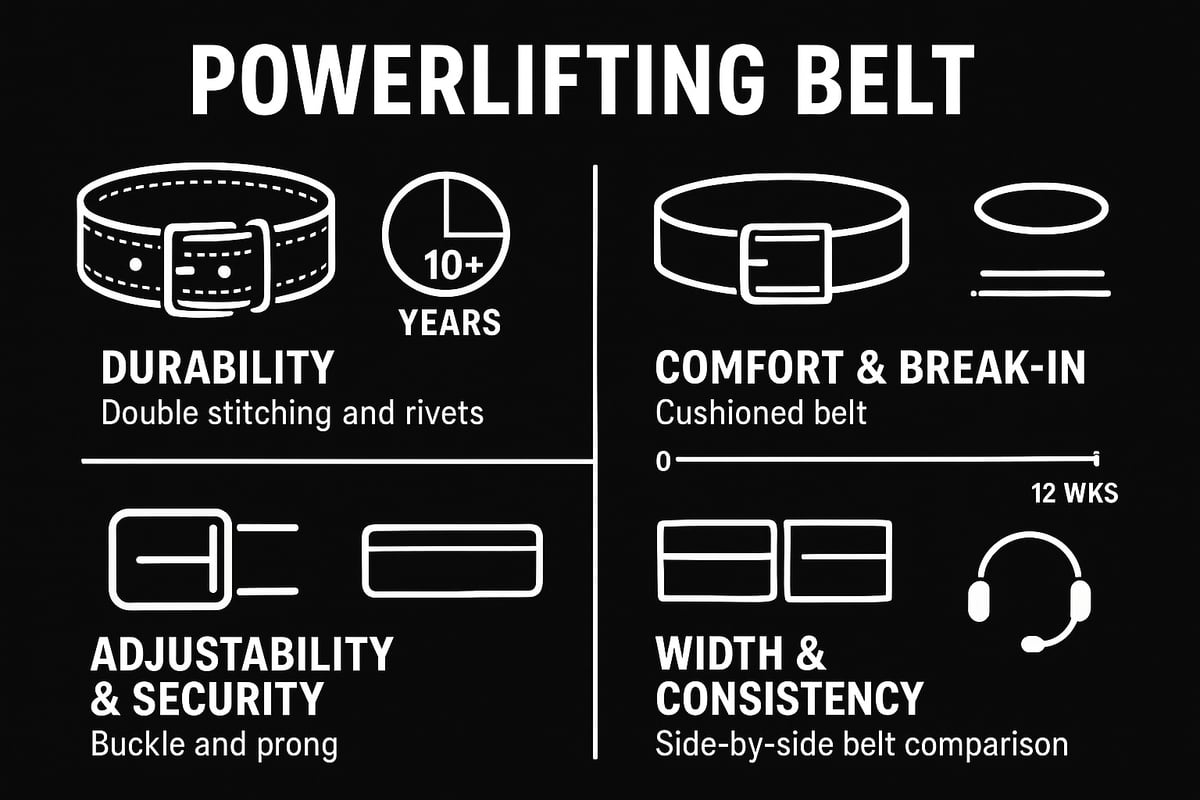
Durability and Construction Quality
A great powerlifting belt should last for years, even under intense training. Look for double stitching, reinforced rivets, and a heavy-duty buckle. These elements prevent your belt from stretching or breaking down.
Inspect the edges and hardware closely. Signs of poor craftsmanship include uneven stitching, loose rivets, or thin, flimsy leather. Trusted brands like SBD are known for robust construction, as detailed in this SBD Powerlifting Belt Review. Investing in a quality powerlifting belt means reliable support every session.
Comfort and Break-In Period
Every powerlifting belt feels stiff at first, especially high-quality leather models. Expect a break-in period, which can range from a few weeks to several months. During this time, the belt will mold to your body and become more comfortable.
Tips for breaking in a new belt:
- Wear it for short periods during lighter lifts.
- Gently roll and flex the belt by hand.
- Avoid soaking or excessive heat, as this can damage materials.
A belt that becomes comfortable over time will make a noticeable difference in your training.
Adjustability and Security
The fit of your powerlifting belt is crucial for both safety and performance. Look for belts with closely spaced holes, solid prong designs, or reliable lever mechanisms. These features guarantee a snug, secure fit that won’t slip or loosen mid-lift.
A secure powerlifting belt can prevent injuries by keeping your core stable throughout heavy lifts. Always check the buckle and prongs before each use for any signs of wear or malfunction.
Width and Consistency
Standard competition powerlifting belts are typically 10cm wide, offering uniform support around your torso. However, some lifters may prefer narrower or tapered belts for comfort, especially if they have a shorter torso or unique body type.
Here’s a quick comparison:
| Belt Width | Best For | Comfort |
|---|---|---|
| 10cm | Most lifters, competition | High |
| <10cm | Shorter lifters | Moderate |
| Tapered | Mobility-focused lifts | Variable |
Choosing the right width ensures your powerlifting belt provides consistent support where you need it most.
Warranty and Customer Support
A reputable powerlifting belt should come with a solid warranty and responsive customer service. Look for brands offering multi-year or lifetime warranties that cover defects in materials or workmanship.
Strong warranty policies show a manufacturer’s confidence in their product. Before buying, check reviews and brand reputation for handling warranty claims and customer questions. This ensures peace of mind and long-term value from your investment.
Top Powerlifting Belt Brands and Models in 2025
Choosing the right powerlifting belt starts with understanding which brands lead the market in 2025. As the sport grows, brands innovate to offer belts that balance support, durability, and comfort for every type of lifter.
Overview of Leading Brands
The powerlifting belt market is dominated by a few trusted names in 2025. SBD is renowned for premium construction and strict competition standards. Inzer offers a wide range of belts, from beginner to elite, known for their reliability. Rogue stands out with American-made quality and strong warranties, appealing to those who value craftsmanship. Pioneer is famous for its customizable designs and innovative closure systems, while Eleiko is highly respected for European engineering and IPF approval.
Each of these brands has earned its place by consistently delivering powerlifting belt options that meet the needs of serious athletes. Their reputation is built on years of feedback from lifters worldwide.
Best Powerlifting Belts for Beginners
New lifters need a powerlifting belt that is easy to use, affordable, and comfortable from day one. The Rogue Echo belt is a top choice, offering solid support without breaking the bank. Inzer Forever Single Prong is another favorite, balancing quality and price with a straightforward design.
Beginner-friendly belts usually feature:
- 10mm thickness for comfort and flexibility
- Single prong or lever closures for easy adjustments
- Durable materials that require minimal break-in
Choosing a beginner powerlifting belt ensures you build confidence and technique without overcomplicating your setup.
Best Powerlifting Belts for Advanced Lifters
Experienced athletes look for a powerlifting belt that delivers maximum support and customization. The SBD 13mm Belt is a standout, offering unmatched rigidity and quick-release features for competition. The Pioneer Cut belt is also highly praised for its innovative hole spacing, which allows for micro-adjustments in fit. For a detailed review of the Pioneer Cut's unique features and customization options, check out this Pioneer Cut Powerlifting Belt Review.
Advanced lifters might also consider Inzer Lever and Eleiko Competition belts, both designed for heavy training and longevity. These models often come with:
- 13mm thickness for elite-level support
- Lever closures for quick on/off
- Options for custom embroidery or colors
Investing in a high-end powerlifting belt can make a noticeable difference as you push for new personal records.
Comparison Table: Key Specs and Prices
Below is a quick comparison of top powerlifting belt models in 2025:
| Brand | Model | Thickness | Closure | Price (USD) | Warranty |
|---|---|---|---|---|---|
| SBD | 13mm Lever | 13mm | Lever | $250 | 2 Years |
| Inzer | Forever Lever | 13mm | Lever | $130 | Lifetime |
| Rogue | Echo | 10mm | Single Prong | $65 | 1 Year |
| Pioneer | Pioneer Cut | 10/13mm | Single Prong | $120 | Lifetime |
| Eleiko | Competition | 13mm | Lever | $200 | 1 Year |
This table helps highlight the differences in support, closure, and value among leading powerlifting belt choices.
Where to Buy: Authorized Retailers and Online Stores
To avoid counterfeit products, always purchase your powerlifting belt from authorized retailers or the brand's official website. Reputable stores like Rogue Fitness, SBD, and Strength Shop provide clear warranty information and customer support.
Watch out for suspiciously low prices, misspelled brand names, or poor-quality images. Genuine powerlifting belts come with clear branding, robust build quality, and reliable after-sales service. When in doubt, contact the manufacturer directly to confirm the retailer's legitimacy.
Powerlifting Belt Maintenance and Longevity Tips
Proper care of your powerlifting belt is crucial if you want it to deliver reliable support for years. A well-maintained belt not only boosts your performance but also protects your investment. By following a few simple routines, you can keep your powerlifting belt in top shape, whether it's leather or synthetic.
Cleaning and Storage Best Practices
Keeping your powerlifting belt clean is simple but essential. For leather belts, wipe down the surface with a damp cloth after each session. Use mild soap for deeper cleaning, but avoid soaking the leather. Synthetic belts can handle gentle soap and water more easily.
Always let your powerlifting belt air dry before storing it. Never leave it in a gym bag where moisture can trap odors or cause mold. Store your belt flat or rolled loosely in a cool, dry place, away from direct sunlight or heaters.
- Wipe after every workout
- Deep clean monthly
- Store in a ventilated area
A clean powerlifting belt will stay odor-free and maintain its stiffness and support for longer.
Regular Inspection and Safety Checks
Inspect your powerlifting belt regularly for signs of wear and tear. Look for cracks in the leather or synthetic material, loose stitching, and any issues with rivets or the buckle. Pay special attention to the holes and edges, as these areas often wear down first.
If you notice any damage, address it immediately. Minor issues, such as loose stitching, can sometimes be repaired. However, significant cracks or a malfunctioning buckle are signs it's time to replace your powerlifting belt.
- Check for cracks and splits
- Test the buckle and rivets
- Inspect all stitching
For a real-world example of how quality impacts longevity, see this Eleiko Weightlifting Belt Review.
How to Break In Your New Belt
A new powerlifting belt may feel stiff and uncomfortable at first. To break it in, wear it during lighter sessions and gradually increase the load. Gently roll and unroll the belt by hand to soften the material, but avoid aggressive bending or twisting.
Leather belts usually take a few weeks to conform to your body, while synthetic ones break in faster. Never use oils or conditioners not recommended by the manufacturer, as these can weaken the material.
- Start with light sessions
- Gradually increase intensity
- Roll the belt to soften
Patience is key; a well-broken-in powerlifting belt molds to your torso, offering superior comfort and support.
Maximizing Belt Lifespan
To maximize the lifespan of your powerlifting belt, avoid over-tightening, which can stress the material and hardware. Rotate between belts if you train frequently, giving each belt time to rest and recover its shape.
Always use your powerlifting belt only for its intended purpose. Avoid using it for movements that don't require extra support, as this reduces unnecessary wear. With proper care, many belts last over five years, maintaining their support and reliability.
- Rotate belts if possible
- Avoid excessive tightening
- Use only for heavy lifts
By following these steps, your powerlifting belt will remain a dependable part of your lifting gear for many years.
Frequently Asked Questions About Powerlifting Belts
Choosing the right powerlifting belt is just the start. Many lifters have questions about when to use a belt, how tight it should be, and how to get the most value for their investment. Here are answers to the most common questions, helping you make confident decisions in your lifting journey.
Do Powerlifting Belts Really Prevent Injury?
A powerlifting belt can significantly reduce the risk of injury during heavy lifts. Research shows that wearing a powerlifting belt increases intra-abdominal pressure, which stabilizes your spine and helps protect your lower back. This support is especially important when lifting near your max. However, a powerlifting belt is not a substitute for proper technique. Always focus on form first. Studies indicate belts can cut back injury rates, but only when used correctly.
Can I Use a Powerlifting Belt for Other Lifts?
Yes, you can use a powerlifting belt for lifts beyond the squat, deadlift, and bench press. Many athletes wear a powerlifting belt during overhead presses, rows, or even Olympic lifts. However, some movements, like cleans or snatches, may feel restrictive with a stiff belt. For those interested in accessory gear, check out Good Wrist Straps for Lifting to further support your grip during high-rep sets or pulling movements. Remember, the powerlifting belt is best reserved for your heaviest compound lifts.
How Tight Should My Belt Be?
Your powerlifting belt should feel snug but not painful. You want enough tightness to brace your core, but you should still be able to take a deep breath. A good rule: slip your hand between your body and the belt with some resistance. If you feel dizzy or cannot breathe deeply, the powerlifting belt is too tight. Adjust as needed for comfort and support.
Are Expensive Belts Worth It?
Expensive powerlifting belts usually offer better materials, craftsmanship, and longer warranties. While a budget powerlifting belt can work for beginners, advanced lifters often benefit from belts that last longer and provide more consistent support. Consider your training frequency and goals. Investing in a high-quality powerlifting belt can save you money in the long run by avoiding frequent replacements.
| Feature | Budget Belt | Premium Belt |
|---|---|---|
| Material | Basic leather/synthetic | Premium leather |
| Warranty | 6-12 months | 2-10 years |
| Longevity | 1-3 years | 5+ years |
What’s the Difference Between Powerlifting and Weightlifting Belts?
A powerlifting belt is typically wider and the same width all around, providing maximal support for the core and lower back. Weightlifting belts are often tapered, wider in the back, and narrower in the front for greater mobility during Olympic lifts. Competition rules may also vary, so always check requirements if you plan to compete with your powerlifting belt.
How Often Should I Replace My Belt?
Replace your powerlifting belt when you notice cracks, stretched holes, loose rivets, or if the buckle fails. With proper care, a high-quality powerlifting belt can last five years or more. Cheaper belts may wear out within one to three years. Regular inspection keeps your gear safe and effective.
Can I Compete With Any Belt?
Not every powerlifting belt is approved for competition. Most federations, like the IPF and USAPL, have strict guidelines on width, thickness, and fastener type. Always check your federation’s rulebook before buying a new powerlifting belt. This ensures you meet all requirements and avoid surprises on meet day.
Now that you know what makes a great powerlifting belt and how the right support can level up both your safety and performance in 2025, it’s time to put that knowledge into action. Whether you’re just starting out or looking for a premium upgrade that’ll last for years, choosing the right belt is the first step toward unlocking your true strength. At Katamu, we’ve got high quality lever belts with awesome designs built for real gymgoers like you. Ready to take your setup to the next level and lift with confidence Check out our collection and build your setup.
